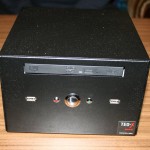HowTo: VDR in den Systemstart einbinden
Um einen Video Disk Recorders (VDR) sofort nach dem Start mit der Fernbedienung zu steuern, ist es notwendig ihn automatisch zu starten. Außerdem sollte er für gesetzte Timer automatisch aufwachen, um diese aufzunehmen. Ich verwende dazu jeweils ein Start-Skript für VDR und Xine, zusätzlich noch ein Shutdown-Skript für VDR.
Shutdown-Skript
Shutdown-Skript erstellen
vi /usr/src/VDR/shutdown.sh
#!/bin/sh
#
# shutdown.sh
# wake up method ('off','acpi','nvram','suspend')
WAKEUP_METHOD="acpi"
# read board configuration from specified configuration file (e.g: "/etc/nvram-wakeup.conf")
NVRAM_CONFIG=""
# specify the iw (infowriter) name. (e.g: gigabyte_5aa)
NVRAM_IWNAME=""
# try "nvram-wakeup --help"
NVRAM_OPT="--syslog"
# Which boot manager are you using? (grub/lilo)
BOOT_MANAGER="grub"
TIMER=$1
LILOCNF=/etc/lilo.conf
GRUBCNF=/boot/grub/menu.lst
ACPIALARM=/proc/acpi/alarm
case ${#TIMER}-${WAKEUP_METHOD:-off} in
10-acpi)
test -e $ACPIALARM
case $? in
0) date -d "1970-01-01 UTC $(($TIMER-120)) seconds" +"%Y-%m-%d %R:%S" > $ACPIALARM
sudo poweroff
exit 0
;;
*) logger -t ${0##*/} "ARG -> missing $ACPIALARM"
;;
esac
;;
10-nvram)
eval test $(echo $NVRAM_OPT | egrep -q directisa || echo "-e /dev/nvram -a") -e /dev/rtc -a -e /dev/mem
case $? in
0) which nvram-wakeup >/dev/null 2>&1
case $? in
0) sudo nvram-wakeup -s $TIMER $NVRAM_OPT ${NVRAM_CONFIG:+-C $NVRAM_CONFIG} ${NVRAM_IWNAME:+-I $NVRAM_IWNAME}
case ${BOOT_MANAGER:-lilo} in
grub) REBOOT_LINE=`grep -s ^title "$GRUBCNF" | grep -i -n poweroff | { IFS=: read a b ; echo $a ; }`
test -n "$REBOOT_LINE"
case $? in
0) which grub-set-default >/dev/null 2>&1
case $? in
0) which grubonce >/dev/null 2>&1
case $? in
0) sudo grubonce $((REBOOT_LINE-1))
;;
*) sudo grub-set-default $((REBOOT_LINE-1))
;;
esac
;;
*) echo -e "savedefault --default=$((REBOOT_LINE-1)) --once\nquit" | sudo grub --batch
;;
esac
;;
*) logger -t ${0##*/} "ARG -> missing poweroff entry in $GRUBCNF"
;;
esac
;;
lilo) REBOOT_ENTRY=`grep -s -i label.*poweroff "$LILOCNF" | { IFS== read a b ; echo $b ; }`
test -n "$REBOOT_ENTRY"
case $? in
0) sudo lilo -R $REBOOT_ENTRY
;;
*) logger -t ${0##*/} "ARG -> missing poweroff entry in $LILOCNF"
;;
esac
;;
esac
sudo shutdown -r now
exit 0
;;
*) logger -t ${0##*/} "ARG -> missing nvram-wakeup"
;;
esac
;;
*) logger -t ${0##*/} "ARG -> missing $(echo $NVRAM_OPT | egrep -q directisa || echo /dev/nvram -o) /dev/rtc -o /dev/mem"
;;
esac
;;
10-suspend)
test -e $ACPIALARM -a -e /sys/power/state
case $? in
0) date -d "1970-01-01 UTC $((TIMER-120)) seconds" +"%Y-%m-%d %R:%S" > $ACPIALARM
echo mem > /sys/power/state
sudo reboot
exit 0
;;
*) logger -t ${0##*/} "ARG -> missing $ACPIALARM -o /sys/power/state"
;;
esac
;;
10-off)
logger -t ${0##*/} "MESG -> no wakeup method"
;;
1-*)
logger -t ${0##*/} "MESG -> no timer"
;;
esac
sudo shutdown -h now
exit $?
Runvdr
Runvdr bearbeiten
vi /usr/src/VDR/runvdr
#!/bin/bash
# runvdr: Loads the DVB driver and runs VDR
#
# If VDR exits abnormally, the driver will be reloaded
# and VDR restarted.
#
# In order to actually use this script you need to implement
# the functions DriverLoaded(), LoadDriver() and UnloadDriver()
# and maybe adjust the VDRPRG and VDRCMD to your particular
# requirements.
#
# Since this script loads the DVB driver, it must be started
# as user 'root'. Add the option "-u username" to run VDR
# under the given user name.
#
# Any command line parameters will be passed on to the
# actual 'vdr' program.
#
# See the main source file 'vdr.c' for copyright information and
# how to reach the author.
#
# $Id: runvdr 2.0 2006/05/14 16:02:05 kls Exp $
export LANG=de_DE
export LC_COLLATE=de_DE
VDRDIR="/usr/src/VDR"
VDRPRG="./vdr"
VDRCMD="$VDRPRG -t /dev/tty8 -w 60 -c /etc/vdr -E /var/vdr --vfat \
-P 'xine -r' -P streamdev-server -P streamdev-client \
-P epgsearch -P live -P 'dvd -C /dev/dvd' \
-P 'osdteletext -d /tmp/vtx' \
-P 'remote -i /dev/input/remote' \
-s /usr/src/VDR/shutdown.sh
$*"
KILL="/usr/bin/killall -q -TERM"
# Detect whether the DVB driver is already loaded
# and return 0 if it *is* loaded, 1 if not:
function DriverLoaded()
{
return 1
}
# Load all DVB driver modules needed for your hardware:
function LoadDriver()
{
modprobe dvb_ttpci
modprobe budget_ci
}
# Unload all DVB driver modules loaded in LoadDriver():
function UnloadDriver()
{
modprobe -r budget_ci
modprobe -r dvb_ttpci
modprobe -r stv0299
modprobe -r lnbp21
}
# Load driver if it hasn't been loaded already:
if ! DriverLoaded; then
LoadDriver
fi
while (true) do
cd $VDRDIR
eval "$VDRCMD"
if test $? -eq 0 -o $? -eq 2; then exit; fi
echo "`date` reloading DVB driver"
$KILL $VDRPRG
sleep 10
UnloadDriver
LoadDriver
echo "`date` restarting VDR"
done
Start-Skript
Start-Skript anlegen
vi /etc/init.d/vdr
#!/bin/bash
/usr/src/VDR/runvdr &
chmod +x /etc/init.d/vdr
update-rc.d vdr defaults
Adding system startup for /etc/init.d/vdr ...
/etc/rc0.d/K20vdr -> ../init.d/vdr
/etc/rc1.d/K20vdr -> ../init.d/vdr
/etc/rc6.d/K20vdr -> ../init.d/vdr
/etc/rc2.d/S20vdr -> ../init.d/vdr
/etc/rc3.d/S20vdr -> ../init.d/vdr
/etc/rc4.d/S20vdr -> ../init.d/vdr
/etc/rc5.d/S20vdr -> ../init.d/vdr
Start-Skript für Xine anlegen
vi /usr/src/VDR/xinestart.sh
#!/bin/sh
xine -pqhf --no-splash --post vdr_video --post vdr_audio --post upmix_mono "vdr:/tmp/vdr-xine/stream#demux:mpeg_pes"
chmod +x /usr/src/VDR/xinestart.sh
vi ~/.config/autostart/xinestart.desktop
[Desktop Entry]
Type=Application
Encoding=UTF-8
Version=1.0
Name=Xine-Starter
Name[de_DE]=Xine-Starter
Comment[de_DE]=Startet Xine
Comment=Startet Xine
Exec=sh /usr/src/VDR/xinestart.sh
X-GNOME-Autostart-enabled=true
